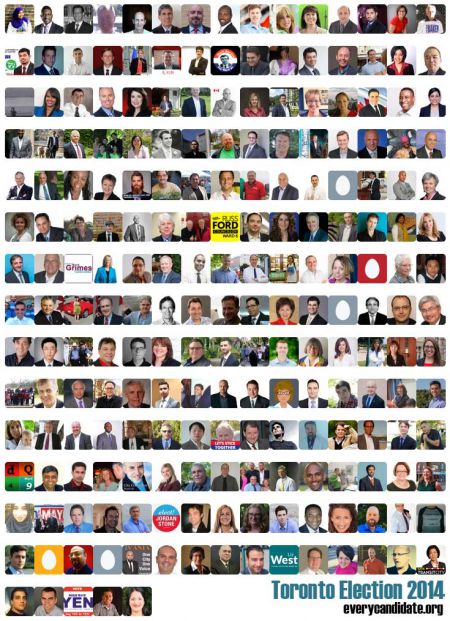This story was originally published at everycandidate.org
Deputy Mayor Norm Kelly is running for re-election in Ward 40, but lives in a different part of Scarborough, almost 11 kilometres away, the distance between the C.N.E. and Highway 401. Howevernone of the candidates running against Kelly live in the ward either.
Out of 358 people competing to become city councillors, 135 of them (38%) registered to run for office using addresses that do not fall within the ward they hope to represent, according to data compiled from their nomination papers.
Of the 37 incumbents running for re-election 12 do not live in the ward that they currently represent.
You can now check which candidates live in your ward by simply visiting their profile page here on Every Candidate. Just look for the map marker .
“Many people don't realize that you can run and not live in the ward,” say Mary-Margaret McMahon, who lives within Ward 32 in the Beaches, the area she represents as a city councillor.
“People are very surprised”, McMahon explained, “they think it is one of the requirements but it is not.”
The rules set out by the province in the City of Toronto Act, do not require a candidate to live within the ward to become a city councillor. They stipulate only that the candidate be eligible to vote in the city, that is someone who either lives in, owns property, or rents property in the Toronto.
“Residents tell me they think their city councillor should live in their ward. They get very upset when candidates are not forthcoming about living outside the ward, even when directly asked” said Mary Fragedakis, the councillor running for reelection in Ward 29.
“I find even candidates who live a kilometre or so outside seem to not know many things about the ward,” Fragedakis expressed.
However this perspective is contrasted by the wide range of other views held by candidates for city council.
“Residents don't care where their candidate lives,” said Sarah Thompson, who resides in Rosedale, but is hoping to move a kilometre and a half west to Ward 20, where she is running for council.
She is cynical about the intentions of those raising the question of where a candidate lives. “It is usually raised as a campaign tactic that rarely gets traction.”
Some city councillors see drawbacks to living inside the ward they represent.
“I intentionally divested from the ward” says Kristyn Wong-Tam, the councillor for downtown's Ward 27. Wong-Tam once lived in the area as well as owning properties and a business in the ward. Wong-Tam now lives roughly half a kilometre away from the ward.
“If I lived within the ward boundaries, I would often find myself in a situation of living too close to the developments and would be required to declare an interest to avoid conflict,” explained Wong-Tam, who worries she would be “abdicating her responsibility” if she had to assign another councillor to oversee condo developments in her area.
Wong-Tam lives only a few blocks from the ward she represents, but other candidates live a decent commute away. Deputy Mayor Kelly did not respond to a request to comment on this story, butRandy Ai, who is running for council further from home explained his motivations.
“I live downtown in a condo, but don't feel connected to that area”, said Ai. He grew up in North York's Ward 24, where he is a candidate. He doesn't foresee a problem closing the more than 12 kilometre distance.
“I would be a five-minute walk from city hall, and I would visit the ward as often as possible. It is only a 25-minute drive away, if the DVP is empty,” Ai added.
The candidate who is running the farthest from home is Amarjeet Chhabra, who lives downtown but is vying for a seat in Scarborough's Ward 44, over 19 kilometres away, further than the distance between the lake shore and the northern city limits.
Not all cities in Ontario operate in the same manner as Toronto. The City of Markham, for example, elects not only a mayor and a councillor to represent each of the city's eight wards, but also elects four regional councillors to serve the city as a whole.
Toronto's system is based on having representatives for 44 different parts of the city, which can result in some Torontonians feeling their interests are not always reflected by their elected city councillor.
“Our city is notorious for having a council that is poorly representative of the people who live in it,” says candidate Jane Farrow (Ward 30).
It is not clear that a councillor living within the ward makes them a better representative, but Farrow contends that “residency and ward boundaries seem to be an issue that doesn't receive enough scrutiny.”
